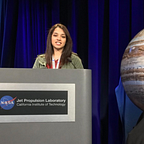Water Volcanoes of Enceladus
Series: Moons of the Solar System
It is one of the brightest bodies in our solar system. The reason is simple. Saturn’s Moon Enceladus is 500km in diameter and is fully covered with fresh water ice, making it reflect all the sunlight that hits it.
It was discovered way back in 1789 by astronomer William Herschel, but nothing much was known about it till the two Voyager missions flew past it in the 1980s. More details and close ups were acquired from the Cassini mission that is currently in orbit around Saturn.
Enceladus has cryovolcanoes — ice volcanoes that eject a plume of water, ice, and dust — in its south pole. The matter ejected from these volcanoes total nearly 200kg per second. A lot of it falls back as fresh snow, keeping the moon looking pristine white. But much of it escape into space and feeds Saturn’s E ring. The presence of volcanoes implies Enceladus is geologically active, with a warm core. In late 2015, actually Cassini passed through a plume in the southern polar region.
Enceladus also has a large subsurface ocean that contains a substantially large body of water. This makes Enceladus a prime candidate for the search for extraterrestrial life. Under the extremely thick layer of ice, the water might be warmer, insulated from space and heated by the core. This might further enable organisms to survive there just like deep sea vents here on earth.
Humans will one day explore Enceladus and its icy secrets in finer detail, and many of these questions will be answered.
Every 2 weeks we send out a newsletter giving you an update of all that is happening at TeamIndus and opportunities for you to engage with us.
